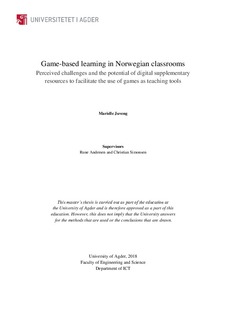| dc.description.abstract | Games are a popular form of entertainment that can keep individuals motivated and engaged for hours at a time. Our motivations to sink multiple hours into playing games have been studied by researchers, instructional designers, and game designers alike, with the goal of understanding and highlighting the elements that have positive or negative effects on the players. Games have also been recognised as a potential teaching and learning tool due to their capability to integrate content and elements that nurture intrinsic motivation, learner engagement, and facilitate different approaches to learning. However, due to a scarcity of research on the use of both analogue and digital games in Norwegian education, it is challenging to discern how frequently Norwegian teachers utilise games as teaching tools. The purpose of this study is to provide insight on teachers’ use, or lack thereof, of game-based learning in Norwegian elementary, lower secondary, and upper secondary education. The study focuses on exploring what makes games beneficial teaching tools, the perceived challenges that hinder the adoption of games, and the potential of digital supplementary resources to facilitate the use of games as teaching tools in classroom contexts.
The study is based on existing theory on motivation, pedagogy, and the facilitation of tools in education, in addition to data collected from Norwegian teachers using a mixed methods approach. The data gathering was conducted in two stages. The first stage utilised a parallel gathering approach, where data was gathered in the same time span through an online questionnaire and through semi-structured interviews. The aim of the research in stage one was to gather information about teachers’ use and beliefs about games as teaching tools, the perceived challenges of using games in classroom contexts, and the potential usefulness of various digital supplementary resources that can assist teachers in using games as teaching tools. The objective of the research in stage two of the study was to evaluate the practical potential of different digital resources to facilitate the use of games as teaching tools in classroom contexts. Four digital resources connected to a self-designed educational board game were developed, based on the data gathered in stage one of the research. A class set of the board game, together with the developed digital supplementary resources, were provided to two teachers in separate classes, who implemented the game in their English lessons. The lessons were observed, and the teachers were interviewed afterwards.
The results reveal that games are to some degree viewed to be beneficial teaching tools by teachers, and that games of different types are utilised in Norwegian classrooms. However, the results suggest that many teachers have limited knowledge connected to the content and elements in games that form beneficial learning environments. According to theories on motivation, games can promote intrinsic motivation and learner engagement due to the integration of content and elements that satisfy the players’ intrinsic psychological needs for autonomy, competence, and relatedness, while offering opportunities to satisfy individual motivations for play (Rigby & Ryan, 2011; Yee, 2005a). Also, games have the capability to facilitate different student-centred approaches to learning, and to integrate content, feedback, and scaffolding systems that when combined promote learner engagement and performance. The results of the research reveal that there are multiple perceived challenges that hinder the adoption of games as teaching tools. A lack of knowledge and skill connected to games as teaching tools is perceived to hinder teachers in identifying and implementing games that are beneficial to use in classroom contexts. Other perceived challenges that hinder teachers include time restrictions, both inside and outside of the classroom, school equipment and economy, classroom management during game use, as well as the beliefs and expectations of colleagues and students. The results indicate that games are used more frequently in classroom contexts with younger students, primarily due to fewer requirements connected to the game content. Games are also more likely to be implemented as teaching tools if they are perceived as easy to access, learn, and to use in lessons. The results show that digital supplementary resources, such as videos and websites containing information, can assist teachers in acquiring knowledge about games as teaching tools, help them acquire and learn new games, and provide recommendations for beneficial classroom implementation. Teachers can also utilise digital resources as a supportive tool during lessons. Additionally, the results reveal that access to resources can aid teachers in developing confidence in their own abilities and teaching methods. These findings align with existing theory on professional development (Ertmer & Ottenbreit-Leftwich, 2010; Lawless & Pellegrino, 2007), and support that access to digital supplementary resources can facilitate the use of games as teaching tools in Norwegian classrooms.
Due to constraints in the study, future research should seek to investigate the long-term effects of access to supplementary resources on game-based learning in Norwegian classrooms, and whether the findings of this study converge with the use of games and the perceived challenges in higher education. An interesting avenue for future research could focus on students’ perspective regarding the use of game-based learning in classrooms, to see if their perceptions align with the perspectives of teachers. It would also be beneficial to conduct research to evaluate the availability of suitable educational games connected to specific subjects or curriculum goals. The findings, alongside the results from this study, have the potential to assist game designers and publishers who want to expand into the education sector to create games and supplementary resources targeting areas of need, which can further facilitate the use of game-based learning in Norwegian classrooms. | nb_NO |

